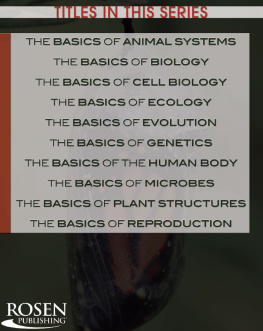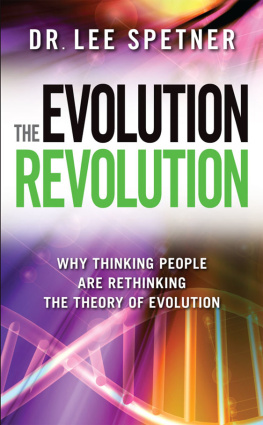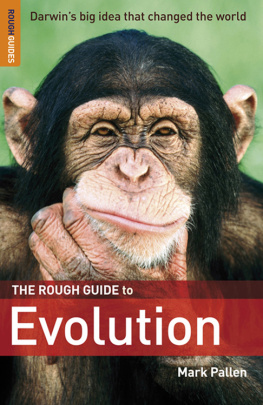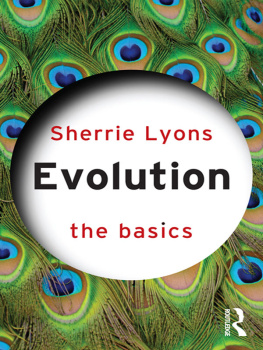
Published 2007 by Prometheus Books
Relics of Eden: The Powerful Evidence of Evolution in Human DNA. Copyright 2007 by Daniel J. Fairbanks. All rights reserved. No part of this publication may be reproduced, stored in a retrieval system, or transmitted in any form or by any means, digital, electronic, mechanical, photocopying, recording, or otherwise, or conveyed via the Internet or a Web site without prior written permission of the publisher, except in the case of brief quotations embodied in critical articles and reviews.
Inquiries should be addressed to
Prometheus Books
59 John Glenn Drive
Amherst, New York 14228-2119
VOICE: 716-691-0133, ext. 210
FAX: 716-691-0137
WWW.PROMETHEUSBOOKS.COM
11 10 09 08 07 5 4 3 2 1
Library of Congress Cataloging-in-Publication Data
Fairbanks, Daniel J.
Relics of Eden : the powerful evidence of evolution in human DNA /
Daniel J. Fairbanks.
p. cm.
Includes bibliographical references and index.
ISBN 978-1-59102-564-1
ISBN 978-1-61592-009-9 (e-book)
1. Molecular evolution. 2. Evolutionary genetics. I. Title.
[DNLM 1. Evolution, Molecular. 2. Genome, Human. 3. Genomicshistory.
4. Human Genome Project. QU 475 F164r 2007]
QH390.F35 2007
572.8'38dc22
2007027126
Printed in the United States of America on acid-free paper

Appendix 3 From Darwin to the Human Genome:
A Brief History

I n recent years, advocates of the creationism and intelligent design movements have successfully promoted history's most sophisticated and generously funded attack on science, claiming that evolution, human evolution in particular, is a theory in crisis. Ironically, during this same period, the Human Genome Project revealed the most powerful evidence of human evolution ever discovered, and other genome projects, especially the chimpanzee and rhesus macaque projects, have substantially augmented that evidence.
With the ongoing controversy over intelligent design, people often ask me to recommend a book on the molecular evidence of human evolution. Unfortunately, most popular human evolution books either fail to include DNA evidence, or, if they do, they cover only a few highlights. Instead, they tend to focus on archaeological, geological, anatomical, physiological, and theoretical evidence with little or no discussion of the literally millions of molecular fossils in DNA. These requests, and my dismay at repeated claims of meager and flawed evidence sup porting human evolution, led me to draft the book you are now reading.
This book comes at a time when the clash between those who perceive evolution as a threat to religious faith and those who view religious fervor as a threat to science is as intense as it ever has been. The first eight chapters of this book, and the three appendices, focus on pure and solid science. Toward the end, however, the final two chapters address this clash and argue for the middle groundthat science and religion are complementary ways of seeking answers and they need not be at odds.
Most of you reading this have varied backgrounds and interests in science, especially in molecular biology. To satisfy these diverse needs, I have chosen to keep the main text of the book as simple and as concise as possible, while still telling the remarkable story the evidence has to offer. For those of you who want additional information, I have written two appendices that explore some of the main topics in the book in more detail and a third appendix that tells the story of how some of history's best scientific minds laid the foundation for the discoveries presented in this book.
You will shortly read about evidence discovered by hundds of scientists. I wish first to acknowledge them and their work, and I hope this book does justice to their extraordinary accomplishments. I also wish to acknowledge those who taught me science, the first being my grandfather, Avard T. Fairbanks, who as a professor, human anatomist, and prominent sculptor opened my eyes to the magnificence of both science and art. I also am especially grateful to professors Clayton White and Duane Jeffery, who, when I was an undergraduate student, helped me explore the wonders of evolution. I recorded the very day, January 30, 1979, when during a discussion on evolution in Dr. White's class I discovered a newfound way of thinking as a scientist. Shortly thereafter I met Dr. Jeffery, who personally helped me work through the change in thought required by that discovery. Now, twenty-six years later, his review of the manuscript for this book has been invaluable.
I owe special thanks to Cecie Starr, who introduced me to book authorship. I greatly appreciate her extraordinary encouragement and assistance over the years and during the development of this book. The teachings of many other professors and colleagues have inspired my passion for science and are reflected in the pages that follow. To them I likewise am grateful. I also thank the thousands of students who enliven the classes I teach. There is no better profession than being a university professor, and the students make it all worthwhile.
Throughout the publication process, the editors and staff of Prometheus Books have exemplified the utmost courtesy and professionalism. I applaud them for their superb work.
It should go without saying that the opinions in this book are entirely my own, and in expressing them by no means do I intend to represent the views of my employer, my colleagues, or the publisher. I have scrupulously tried to ensure that there are no errors but have learned from past publishing experience that in spite of my best efforts at eradicating errors, a few inevitably persist. I apologize in advance for any errors and take sole responsibility for them.
Finally, to my wife, Dr. Donna Fairbanks, and my children, Jonathan, Aaron, and Michael, I am indebted to you for your patience and support.

A wise professor of Russian literature once told me that every university student should take a course in geology. With my love of science, I needed little convincing. It was the spring of 1982, and in a university with over twenty-five thousand students, only three of us enrolled in the course. (To this day I'm still baffled by the lack of interest most students show toward science.) We were the luckiest three students on campus that term. With such a small class, the professor canceled the classroom and we spent most of our time traveling through the mountains studying geological formations. I was astonished at how often we found fossils. For the last week of class, we camped in Capitol Reef National Park, one of the most geologically rich places on Earth. Our professor hadn't told us how he would determine our grades, and we never had any tests, just constant verbal quizzing from him. As we were leaving the park, he pulled the car to the side of the road and told us to climb a nearby hill. Anyone who finds a fossil gets an A in the class, he said with a smirk on his face. We dutifully scampered up the hill to find ourselves on a plateau covered with thousands of fossilized oyster shells. We all got our As.
That summer I saw abundant evidence that the earth was very old and that it contains countless remnants of long-extinct organisms. I saw how scientists carefully studied the multitude of fossils they found to reconstruct as much as possible the history of life on Earth. The fossils we saw that summer in very ancient rocks were obviously different from any modern organisms; those from more recent rocks looked much more like the animals and plants we see today. The progression of life over time from the strange to the familiar was readily apparent.
Next page














